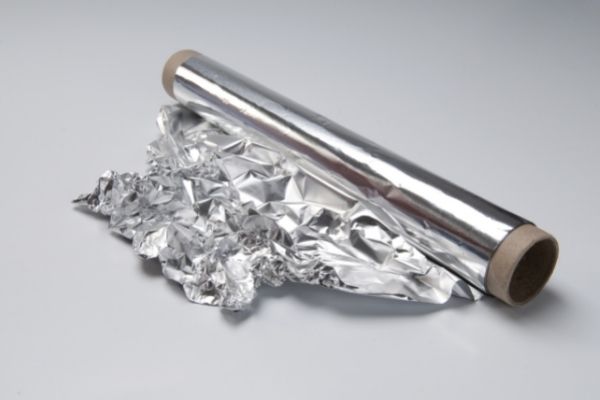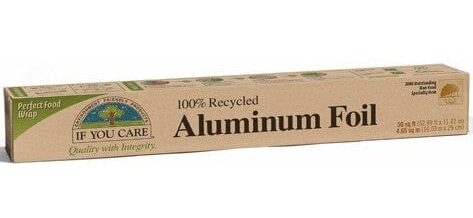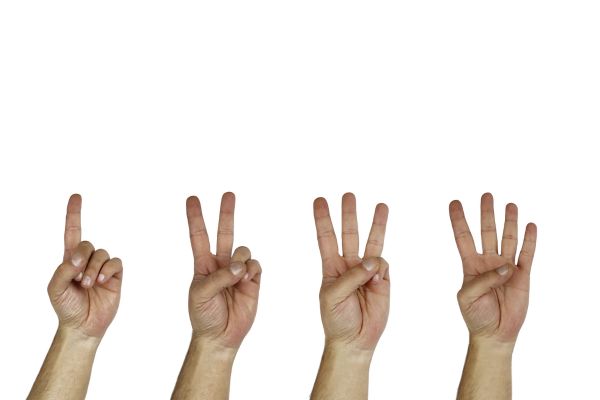Aluminum foil is an essential item for the everyday kitchen and has been for as long as I can remember. Cooking with aluminum foil is popular, especially when it comes to baking and roasting. I can’t remember when there wasn’t a piece of fish in foil on the BBQ. The question on everyone’s mind! Is aluminum foil recyclable?
Aluminum is flaunted as being 100% recyclable, but does this include aluminum foil? Well, yes, aluminum foil is recyclable. There are, however, several things that might get in the way of it being recycled.
Read on to learn what you can do to minimize these two issues below.
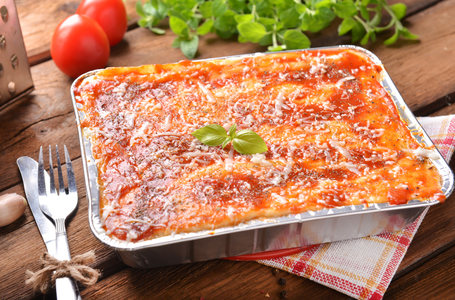

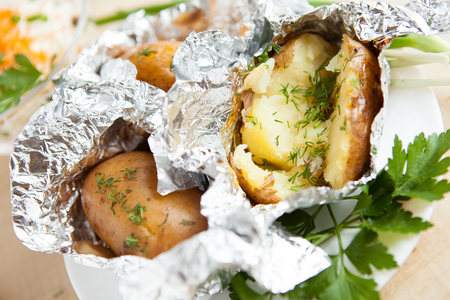
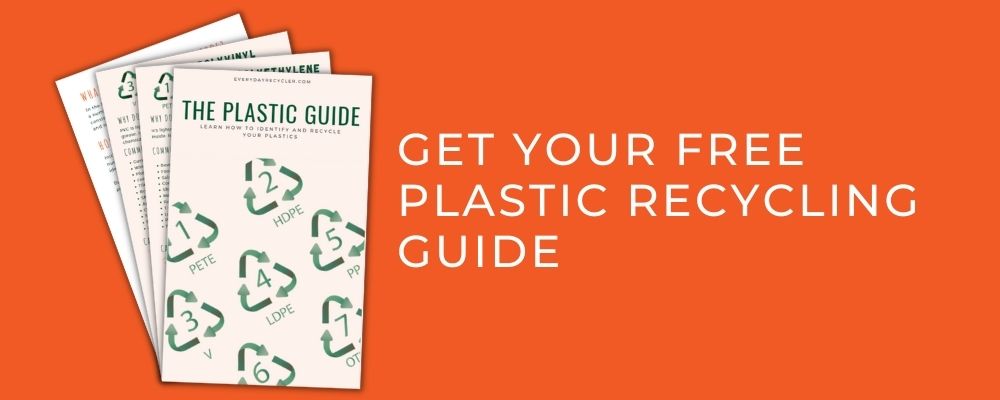
Quick Navigation
What is Aluminum Foil Made of?
Aluminum, a silvery, soft, non-magnetic metal, is mined from bauxite ore. Bauxite is abundant on the earth’s surface and is relatively easy to mine as it occurs quite close to the surface. Aluminum foil is made from very thin sheets of aluminum, less than 0.2m in width.
Explosives are used to break and open up the rock. The top layers are cleared, and the exposed bauxite ore is removed and transported away for refining and smelting. Roughly four to six tonnes of bauxite ore produces only 1 tonne of aluminum.
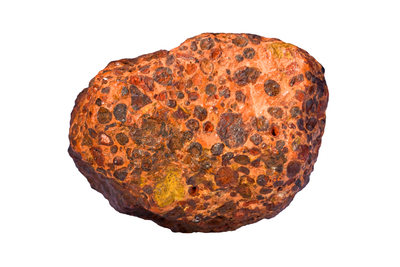
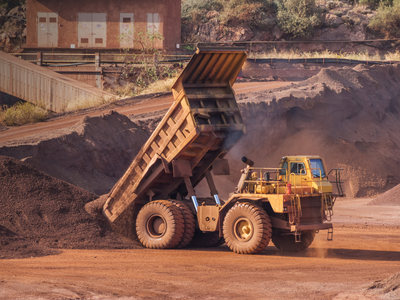
The aluminum is passed through metal rollers that squeeze the metal into the thin foil to make aluminum foil. There are many different thicknesses created for many uses, more uses than just covering your leftovers. Some examples are:
- Pharmaceutical packaging – pill packaging
- Insulation – thermal insulation for the construction industry or insulation for storage tanks
- Electronics – electrical coils for transformers and capacitors for radios and televisions
- Geochemical sampling – protecting rock samples
- Decorative products – many art and craft uses
Why do we still refer to it as “tin foil” in some places? As its name suggests, tin foil is a thin sheet of tin instead of aluminum. Tin foil was the predecessor of aluminum foil, but after World War II, tin foil was replaced with aluminum because it was cheaper and more durable. The name “tin foil” stuck and is still used in many places today.
Did You Know? One of the first commercial uses of aluminum foil was for the foil leg bands on racing pigeons in 1913.
Why do we use it?
Aluminum foil has some features that make it quite useful for many applications. It is inexpensive, durable, lightweight, non-toxic, and greaseproof, although my overly cheesy left-over lasagne severely tests this. It can also be easily molded into different shapes.
In the presence of oxygen, the surface of the metal reacts to form a protective layer. This layer provides a complete barrier to light, oxygen, moisture, and bacteria. These qualities of aluminum foil make it especially useful for food storage.
Other useful applications of aluminum foil require it to be layered with different materials. The foil can be layered with paper, paperboard, or plastic. The purpose of this layering can be for protective or heat-sealing purposes or sometimes might be for decorative purposes.
Although this layering creates materials that are quite good for food and pharmaceutical storage, these materials can be tough to recycle. Once these materials are combined, separating them at the end of their life isn’t easy.
Is Aluminum Foil Recyclable?
Yes, you can recycle aluminum foil.
Just like aluminum cans, aluminum foil can be infinitely recycled. There are a few conditions, however, when it comes to aluminum foil. These are:
- The foil can be heavily covered in food scraps, grease, and oils, making recycling almost impossible.
- The foil is very light and flimsy and may not be picked up in the recycling process.
Unfortunately, a great deal of aluminum foil cannot be recycled because it’s covered in food and oils. If these get into the general aluminum recycling process, they can cause issues and damage recycling equipment.
Some processes are being developed to convert contaminated aluminum into a biofuel production ingredient. This is a great breakthrough; however, getting the dirty aluminum from your kitchen to the lab is probably not likely at this stage.
How to Recycle Aluminum Foil?
Here’s what you do:
- Make sure the aluminum foil is clean.
- It must be free from food scraps, especially the sticky sauces or cheesy messes that often cover foil. Try cleaning it off.
- If there’s too much food on the foil or it won’t come off, even after cleaning, it will have to go into the general waste bin.
- Roll the aluminum foil into a ball. Keep adding foil until you have a ball the size of a baseball or cricket ball.

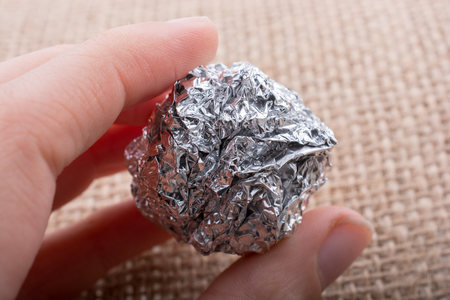
- Next, find out if your local curbside pickup program accepts aluminum.
- If yes, then place this aluminum ball into your curbside recycling bin.
- If not, then another option is to try your local metal recycler. It’s best to collect the foil with aluminum cans and other items to make it worth the trip to the recycling facility. Also, check with your local metal recycler to make sure they accept aluminum foil.
- Find a drop-off location on our resources page.
- Final step – if you need more aluminum foil, then buy recycled aluminum foil. Some brands include:
The steps above work for all aluminum foil products that come into your kitchen, including:
- Aluminum foil wrap
- Pie plates
- BBQ containers
- Baking containers
- Dairy products and other aluminum lids, e.g., yogurt lids or Pringles foil seals
- Non-laminated chocolate, candy, or Easter egg wrappers
If the foil is part of a laminated or multilayer material and is easy to separate, then you should do so. If not, unfortunately, you will probably have to place it in the general waste bin so as not to contaminate other recycling streams.
Reduce and Reuse
There are many ways you can reduce how much aluminum foil you use or even stop using it altogether.
- Reduce
- Buy fit-for-purpose oven dishes for your baking and roasting that can be reused.
- Food Storage and transportation – instead of wrapping things or covering things in aluminum foil, buy eco-friendly reusable containers with lids.
- Be mindful when you are tearing off a piece to use. Consider the energy used to make and transport the aluminum foil to your kitchen and only tear off what you need.
- Reuse
- When the aluminum foil is still in good condition, why not wash, dry, and reuse it?
If you must use something to wrap food, why not try some beeswax wraps or silicone pouches? If these don’t work, try to make sure you use aluminum foil instead of plastic wrap. In some circumstances, plastic wrap can be recycled with your soft plastic recycling. However, this can be tricky, and most places will not accept it. Aluminum foil is a better choice because you can use it over and over again.
DID YOU KNOW? One side of aluminum foil is shinier than the other side. This is because it is too difficult to make a roller with a small enough gap for one sheet, so two sheets are rolled together. When these sheets are separated later, the inside surfaces are matte, and the outside ones are shiny.
What Does Aluminum Foil Become?
Aluminum foil represents only a small portion of our household recycling. However, the industry is still keen to get this valuable material. Using recycled instead of virgin aluminum saves 95% of the energy used.
There are plenty of secure and growing markets for recycled metal, especially with the current push to reduce plastic use. Recycled aluminum is identical to the virgin product, so once re-melted, it can be used to make all the same things. You might even be drinking from a can that has recycled content already.
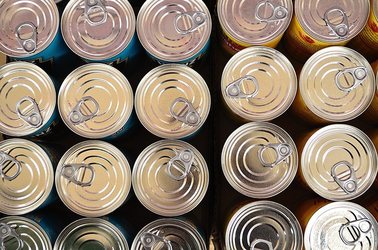
Summary
Although it has a good reputation for being 100% recyclable, not everyone knows if aluminum foil is recyclable. Always try to reduce first if you can. A great idea is to reduce how much aluminum foil you use by putting leftovers in reusable containers or reusable beeswax wraps instead.
Aluminum foil recycling is easy.
- To recycle, make sure the foil is clean. If not, toss it out.
- Roll the aluminum foil into a ball. Keep doing this until you have a ball the size of a cricket or baseball.
- If your local curbside recycling program accepts aluminum, great. If not, try your local metal recycling facility.
- Buy recycled aluminum foil.
Thanks for helping us help our earth.
Sources
- Last Updated 2020, Aluminum foil, Wikipedia
- 2017, ‘Breakthrough’ sees waste aluminium used for biofuel, RTE News
- 2020, Aluminum foil, Encyclopedia.com
- 2002 Aluminium Foil – Recycling, Source Reduction and Energy Recovery, AZoM Materials
- Foil & Packaging, aluminum.org


